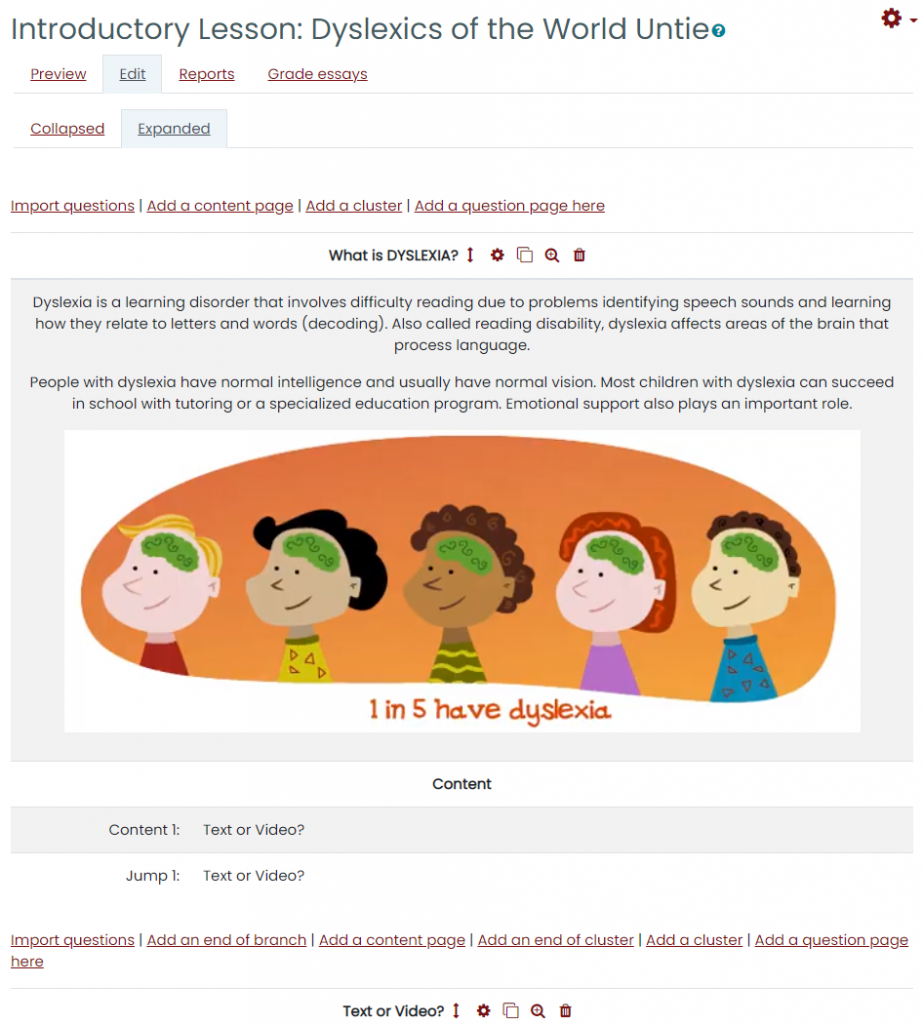Home > User Guides > VLE Guide for Instructors > Adding Instruction Modules > Adding a Lesson to Your Course
Adding a Lesson to Your Course
The lesson module presents a series of HTML pages to the student who is usually asked to make some sort of choice underneath the content area. The choice will send them to a specific page in the Lesson. In a Lesson page’s simplest form, the student can select a continue button at the bottom of the page, which will send them to the next page in the Lesson.
There are 2 basic Lesson page types that the student will see: question pages and content pages. There are also several advanced navigational pages which can meet more specialized needs of the Teacher. The Lesson module was designed to be adaptive and to use a student’s choices to create a self-directed lesson.
The main difference between a Lesson and other activity modules available comes from its adaptive ability. With this tool, each choice the students make can show a different teacher response/comment and send the student to a different page in the lesson. Thus, with planning, the Lesson module can customize the presentation of content and questions to each student with no further action required by the teacher.
Lesson Settings
This page explains the settings involved when first creating a lesson. To add a lesson to your course page:
With the editing turned on at the course main page, locate the section you wish to add your lesson then click the Add an activity or resource link and choose Lesson. All settings may be expanded by clicking the Expand all link at the top right corner.
Configure the following lesson settings:
General
- Name
Whatever you type here will form the link learners click on to view the lesson, so it is helpful to give it a name that suggests its purpose.
Description
Add a description of your lesson here.
- Display description on the course page
- If this box is ticked, the description will appear on the course page just below the name of the lesson.
- If this box is ticked, the description will appear on the course page just below the name of the lesson.
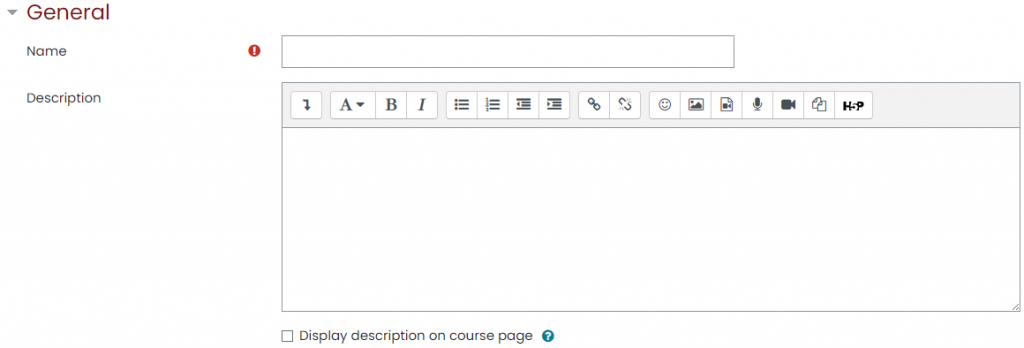
Appearance
- Linked media
- If you want to include a link to a file on the lesson page for students to refer to, upload it here.
- Progress bar
- Choose this to show a bar at the bottom of the page showing how far into the lesson the student has got.
- For lessons containing only Content pages, once a lesson has been taken to the end, if that same lesson is re-taken, the progress bar will not be “reset”, i.e. it will show a 100% progress from page 1!
- For lessons containing Question pages and set to “Re-take” Yes, the progress bar is always “reset” at 0% upon re-take.
- Note that the Lesson Progress bar only works correctly for lessons with a “straightforward” navigation, such as page 1 -> page 2 -> page n -> end of lesson. It is not guaranteed to work with pages “jumping all over the place”.
- Display ongoing score
- Choose this to let students see their score as they work through the lesson.
- Display menu
- Choose this if you want to show a list of the pages in the Lesson so a student can see what is coming up.
- Minimum grade to display menu
- Choose this if you want the student to go through the lesson once and get a grade before they can (on review) see and navigate through all the different pages.
- Slideshow
- Slideshow height, width and background color are set for the whole site by an administrator. Select ‘Yes’ to display the lesson as a slideshow.
- Maximum Number of Answers
- Here you can set the default number of answer boxes available when you add your question or content pages. For instance, if you are only going to use True/False, you would only need 2. You can change this at any time, so it is not crucial.
- Use default feedback
- Choose this if you want to show a set phrase regardless of their answer. If enabled, when a response is not found for a question, the default response of “That’s the correct answer” or “That’s the wrong answer” will be shown.
- Link to next activity
- Choose this to give students a link to another activity when they reach the end of the lesson.
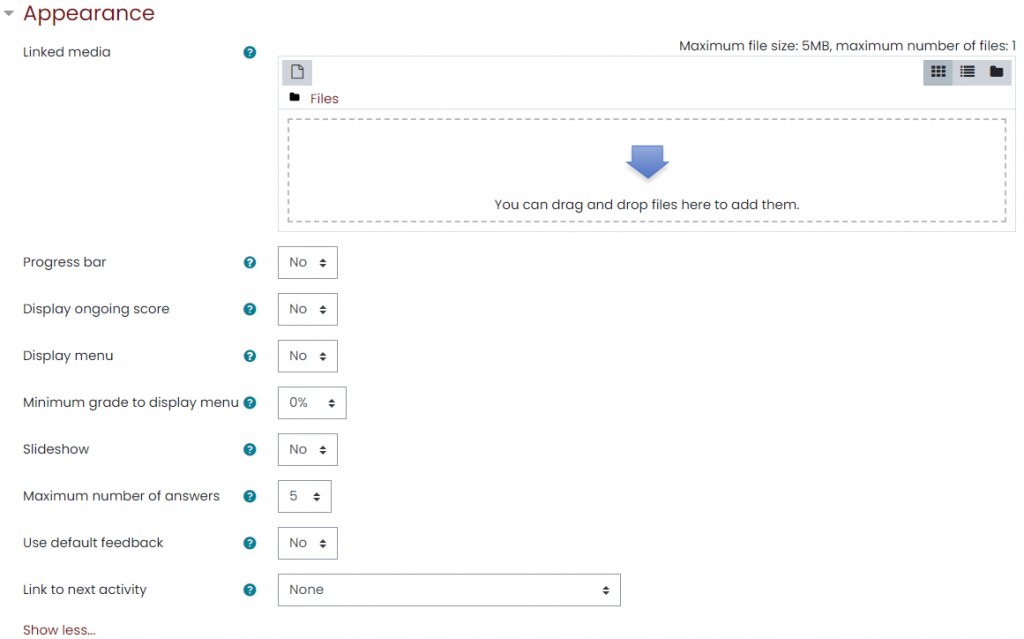
Availability
- Available from/Deadline
- Here you can set a start and end date and time for your Lesson.
- Time limit
- This allows you to set a time limit on the lesson which can now be seconds, minutes, hours, days, or weeks. Students will see a countdown counter in a block as they work.
- The timer does not stop them doing the lesson when the time is up, but correct answers are no longer scored.
- Password protected lesson
- Change to “Yes” and enter the password if you want students only to access it when they know the password.
- Allow lesson to be attempted offline using the mobile app
- Change to “Yes” if you want to allow students to attempt the lesson offline using the Moodle mobile app.

Flow Control
- Allow Student Review
- This puts a “Review Lesson” button on the last screen of the lesson to encourage the students to navigate through the lesson again from the start.
- Note that the students will not be able to change their answers, only view them.
- Provide option to try a question again
- This displays a button after an incorrectly answered question so that the student can try again. (but not get credit for it) Leave this off if you are using essay questions. If enabled, when a question is answered incorrectly, the student is given the option to try it again for no point credit or continue with the lesson. If the student clicks to move on to another question, then the selected (wrong) answer will be followed. By default, wrong answer jumps are set to “this page” and have a score of 0, so it is recommended that you set the wrong answer jump to a different page to avoid confusion with your students.
- Maximum Number of Attempts
- Decide here how many times you want students to be able to attempt each question. When they reach the maximum, they will be taken automatically to the next page.
- Note: this setting works in combination with the above setting, or independently.
- When ‘provide an option to try again’ is set to No, students will be able to retake the question as many times as it is set here, with a score penalty.
- When ‘provide an option to try again’ is set to Yes, then students will be able to retake the question as many times as it is set here without a score penalty. In this case an extra dialogue appears. If answered incorrectly repeatedly, when the maximum is reached, the next page of the lesson is displayed.
- Consequently when the relevant jump ‘this page’ is used in wrong answer while the ‘provide an option to try again’ is set to No and ‘maximum number of attempts’ is set to 1, a student that will answer wrongly will be moved into the next page, since he/she has the change to try the question just once.
- Action after a Correct Answer
- Choose here where you want a student to be sent to if they get a question right. The options are:
- Normal: follow lesson path: the next part of the Lesson (default setting)
- Show an unseen page: a random, unexpected page (Pages are shown in a random order with no page shown twice)
- Show an unanswered page: a random page which they have not yet answered (Pages are shown in a random order, with pages containing unanswered questions shown again)
- Number of pages to show
- You only need this if you have set “Action after a correct answer” to show an unseen or unanswered page. Otherwise, all pages will be seen.
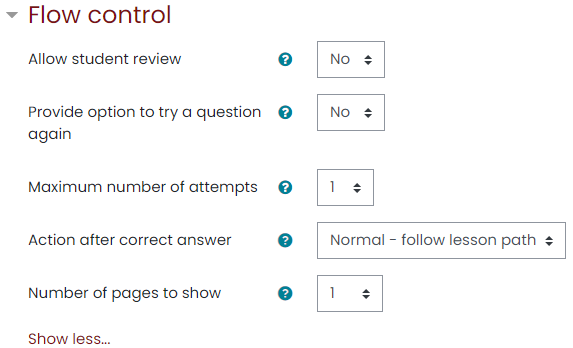
Grade
Set a grade and grade category here, along with a “Grade to pass” which may be connected with activity completion such that a student will not be able to access a follow up activity until they have obtained the required grade in the lesson.
- Practice lesson
- Practice lessons are now saved; this means they will appear in the reports. You must enable the “Retakes allowed” setting if you want students to be able to attempt a practice lesson several times.
- Custom Scoring
- Use this to give a number score (negative or positive) to each answer
- Re-takes allowed
- Choose this if you want your students to be able to do the lesson more than once.
- Note that this setting only applies to lessons containing Question pages. Lessons consisting only of Content pages can be re-taken even if ‘Re-takes allowed’ is set to No.
- Handling of re-take
- If you allow your students to re-take the lesson, then decide here if the grade for all lesson attempts is the mean or the maximum.
- Note that the Question Analysis always uses the answers from the first tries of the lesson. Re-takes by students are ignored.
- Minimum Number of Questions
- Set here the minimum number of questions that will be used to calculate a student’s score. Students will be told how many they have answered and how many more they need to answer.
- If you are using Content pages, then set this to 0.
- If you use this setting, then add some explanatory text at the start of the lesson so the student knows how many questions they must answer as a minimum. (They may answer more).
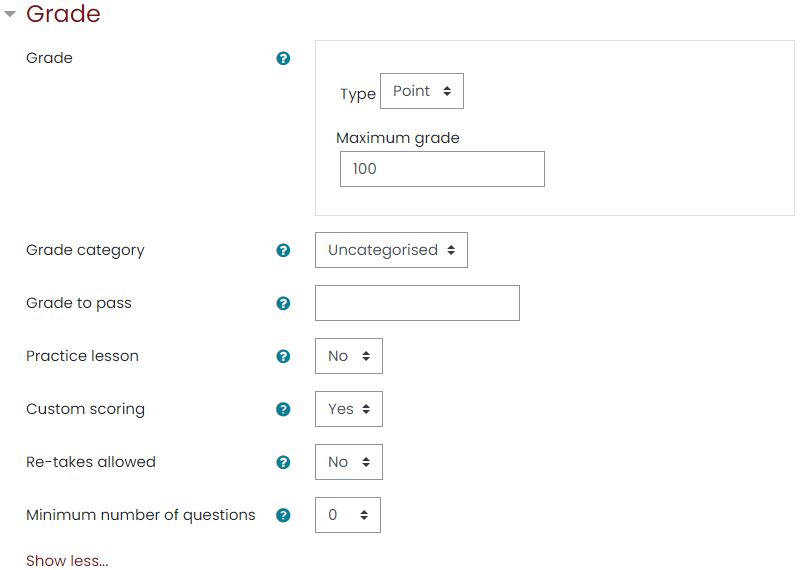
Other settings
Choose the ‘Common module’, ‘Restrict access’, ‘Activity Completion’, and ‘Tags’ settings as you would when you set up any resource or activity. These general settings are further discussed in Activities and Resources: General Settings.
Building your lesson
Planning your lesson
A lesson is made up of pages which may have content for the student to read or questions for them to answer. The questions can be created by the teacher or imported. The teacher decides the order in which these pages appear.
You need to have a clear idea beforehand of what you want to do with this lesson. Is it to be a graded, linear learning experience? Or an ungraded, non-linear practice session? Will students be able to go back and revisit areas or is it just a once-only opportunity?
Even those who are very comfortable working directly online might find it useful to note down on paper the direction they want their lesson pages to go in, rather than having to remember and visualize the navigation in their head.
Adding content and questions to your lesson
When you have set up your lesson with the Lesson settings, click “Save and display” and you will be taken to the screen in the screenshot below.
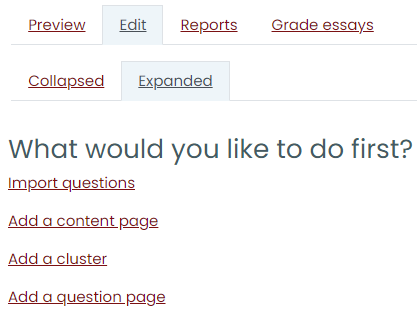
If you click “Save and return to course” instead, then click the “update” icon next to the lesson on the page and click “edit” in Administration>Lesson Administration.
- Import questions
- If you have some questions in the following formats, you can import them to use in your lesson by clicking the Import questions link.
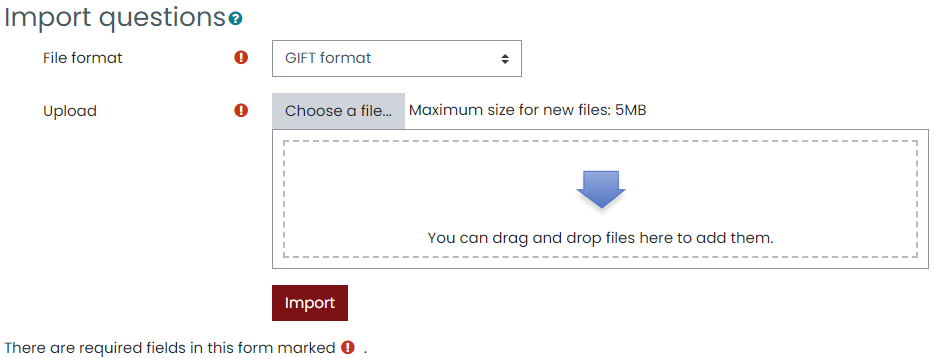
- Add a cluster
- A cluster is a group of question pages which will be offered randomly to a student as they work through the lesson. It is best if you have made the question pages beforehand and can then decide where to mark the start and end of the cluster. The start is marked by a “cluster” page and the end by an “end of cluster” page.
- Add a content
- This is a page where a teacher can provide information to move the lesson forward but without requiring the student to answer specific questions.
- The student sees the page’s title, some information and then one or more buttons at the bottom to select.
- When the student clicks on a button, they go to the next page, but their choice is not scored.
- Page title
– The title of a content page appears to the student at the top of the page.
– A teacher will also see the title in the collapsed edit mode when they are working on the Lesson, and they will also be able to choose the title (and hence this page) from the drop down “jump” lists.
– The title in a content page is also used with the “display left menu” setting.
- Page title
- Page contents
– This is where the teacher can add information for the student, making use of the Text editor and its multimedia features.
- Page contents
- Content
– Here the teacher writes the words they want the student to click on to get to the next part of the lesson.
– These words will appear to the student as a button.
– The teacher can check the box to have the buttons appear horizontally or uncheck it for them to appear centered vertically.
- Content
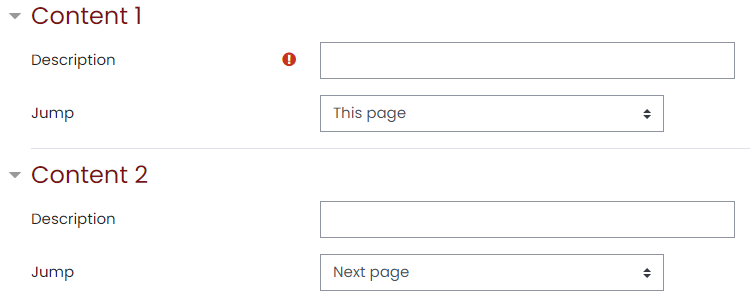
- Number of options available
– How many of these you have depends on your choice in the Maximum Number of Answers setting in Lesson settings
- Number of options available
- The Jump
– Each Description in a Content page has a Jumps menu. “Jumps” take a student from one page to another.
– A “relative jump” is “next page” or “end of lesson” whereas an “absolute jump” gives the actual name of a page.
– The teacher chooses from the dropdown the correct page to send the student to if they click on the button that will be made from this description. Any pages created by the teacher will have their titles appear in this dropdown, allowing them to be selected.
– When a student clicks on a description button, they are sent to the page defined in the Jump associated with the button.
- The Jump
- Add a question page
- From this link you can choose from a variety of question types which will then be added as pages to your lesson.
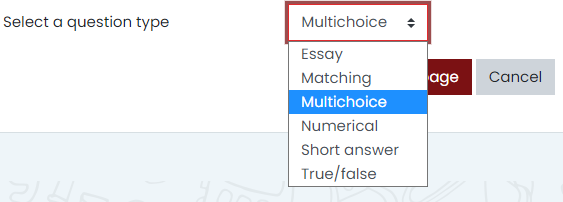
- A typical question page could include:
- Title – the name the student sees at the top of the question page.
- Page contents – the actual question
- Answer/Response/Jump/Score
- Question types
- Multichoice
– The student is given a question and a list of answers. The answer list will be shuffled every time the question is view by a student. By default, they choose one answer, but you can check the box “multiple answer” to allow them to choose more than one answer.
– The file picker is available in the editor so that images and other media may be uploaded as part of the answers and responses.
- Multichoice
- Essay
– Students can write a longer answer as part of the lesson and this can be graded manually by the teacher. When grading the essay, the teacher has access to the editing toolbar to allow comments to be formatted.
– If the main purpose of your lesson is for students to write an essay, consider the Assignment module instead.
- Essay
- Matching
– This allows you to set up lists which must be matched against other lists, for instance, words, pictures, numbers etc. The student must match all correctly to receive the score.
- Matching
- Numerical
– This requires a number as an answer. A number within a range may also be accepted as correct. The range separator to be used is the colon (:). For example, to accept as correct any number between 10 and 12 (10, 11 and 12) you would type 10:12 in the answer box. Only the plain text editor is available in the answer box.
- Numerical
- Short answer
– A student must provide a single word or short phrase answer. The teacher must anticipate the possible answers and enter them in the answer box, using ** wild cards if appropriate. Only the plain text editor is available in the answer box.
- Short answer
- True/false
– The student is given a sentence and must decide if it is true or false.
- True/false
Moving your lesson forward
Once you have added your first content or question page, you reach the next screen which displays your page title/type/jumps (i.e. where the responses take the student to) and actions you can take next:

The Actions icons allow you to move (if you have more than one), edit, preview, or delete your pages.
The drop down allows you to create another page of your choice:
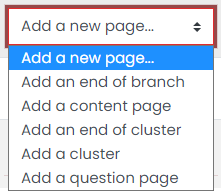
Note the different view options:
- Collapsed view
This gives a brief outline of the lesson structure as in the two screenshots above.
- Expanded view
Ending your lesson
To bring the lesson to a close, select the “End of Lesson” option from the Jump menu on any relevant pages.
The student will then see a generic message, with a direction back to the main course page or to view their grades.
